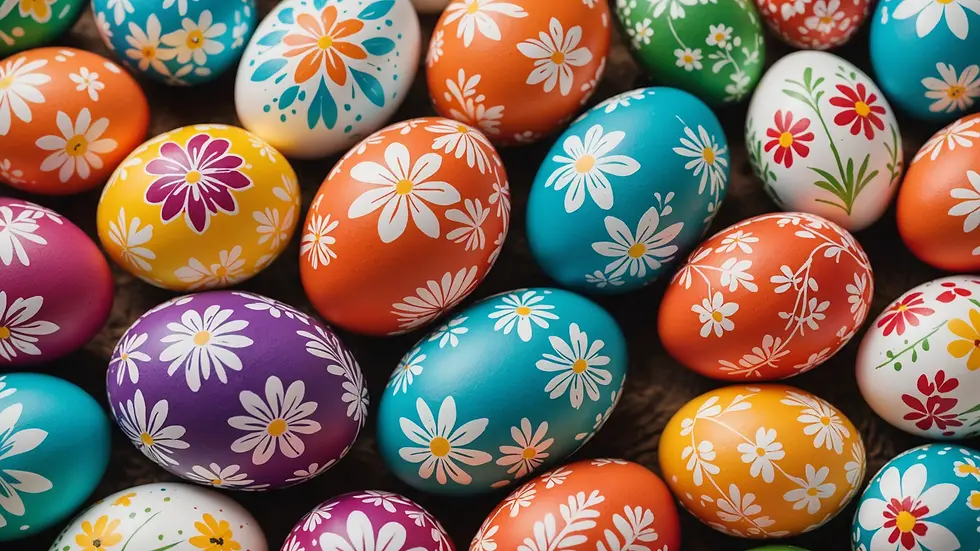Uncovering the Ancient Mysteries of the Springtime Egg: A Journey of Symbolism and Rebirth
- koadofthecrossroad
- Mar 2
- 4 min read
Spring is a vibrant season that infuses the world with life. It signals the end of cold winter days and brings forth colorful blooms and fresh beginnings. At the heart of this seasonal change is the goddess Eostre, revered in Germanic mythology as a symbol of spring and dawn. The egg plays a crucial role in the rituals that honor Eostre, serving as a powerful representation of rebirth and renewal—a symbol that transcends cultures around the globe.
The Symbolism of the Egg
Eggs have a rich history as a potent symbol of new life and transformation. In various cultures, they embody the potential for growth and renewal. The Celts held the egg in high regard, and the Druids considered it a sacred emblem, particularly during the spring equinox. For instance, some Irish legends speak of eggs being found in the nests of mythical birds, signifying hope and new beginnings.
Traditionally, springtime practices include decorating, exchanging, burying, or consuming eggs. These customs symbolize the connection with spring deities and establish a time of rejuvenation and fertility. In fact, according to a survey conducted in 2022, 89% of families in the United States decorate eggs as part of their Easter celebrations, showcasing the ongoing significance of this ancient symbol.
Eostre: Goddess of Spring
Eostre, celebrated across various Germanic cultures, embodies dawn and the arrival of spring. Her name is derived from the Old English term for April, “ēostre,” which signals the return of warmth and light. Festivals honoring Eostre often focus on fertility, growth, and renewal, reflecting the seasonal agricultural cycles.
The Egg of Eostre is not just a seasonal decoration; it carries profound meanings linked to the rhythm of nature. Rituals during her festivals encourage participants to deepen their bonds with their communities and environments, emphasizing the importance of rebirth in spring.
The Egg in Cultural Traditions
Across the globe, many cultures embrace the egg as a powerful symbol of renewal. In Hindu cosmology, the Hiranyagarbha, or golden world-egg, is believed to be the source of the universe and all life. This ancient idea captures the essence of creation, highlighting how deeply rooted the concept of the egg is in various belief systems.
In Japan, sacred eggs are often depicted in art as symbols of creation and rebirth, adorned in brilliant colors that celebrate life. Meanwhile, in China, the practice of painting eggs is predominant during events like the Qingming Festival, where families exchange beautifully decorated eggs as tokens of luck and prosperity.
The Mysteries of the Astarte Egg
The egg's significance crosses geographical boundaries. In ancient civilizations like Egypt and Syria, the goddess Astarte is said to have emerged from a great egg that fell from the heavens, landing in the waters of the Euphrates River. Legend has it that fish gathered to push this egg ashore, enabling doves to roost upon it and hatch.
This egg symbolizes more than just creation; it represents drive and vision. Astarte's legacy echoes through time as she became connected with fertility and the essence of spring, influencing the modern celebration of Easter.
Dual Meanings of the Mystic Egg
Astarte’s egg carries dual meanings: the “mundane egg,” which symbolizes the physical world, and the spiritual notion akin to the ark from ancient flood stories. In this light, the egg serves as a protective shell, harboring life and potential, just as a chick is nurtured before breaking free.
The Church further transformed the mystic egg into a powerful Christian symbol. Doves, commonly associated with Astarte, helped strengthen the eggs' connections to rebirth and resurrection, especially in the context of Christ’s teachings. Over time, prayers emerged that celebrated the egg not just as nourishment but as a reminder of spiritual renewal.
The Egg in Language and Symbolism
Interestingly, the word for "egg" varies across cultures, each carrying unique meanings. In Hebrew, the egg is known as Baitz (masculine) or Baitza (feminine), while Chaldean and Phoenician terms—Baith or Baitha—literally mean "house." This linguistic connection emphasizes the protective and nurturing aspects of the egg, reinforcing its status as a vessel of life.
These variations point to the egg's vital role as a container of potential, symbolizing life in numerous myths and stories. Its presence across cultures showcases its importance in the human experience.
The Legacy of the Egg in Modern Celebrations
As seasons change, traditions surrounding eggs have adapted and become integral to modern celebrations. Decorating eggs, especially during Easter, has evolved into a beloved family activity. From vibrant colors to elaborate designs, these eggs reflect the joy and renewal of spring, embodying life's cyclical nature.
Today, the springtime egg continues to symbolize hope, rebirth, and community. Through various celebrations and rituals, people come together to honor the enduring legacy of the egg. It serves as a bridge between ancient practices and contemporary life, illustrating how traditions evolve yet still hold deep meaning.
Embracing the Spirit of Spring
As we immerse ourselves in the energy of spring, the mysteries of the springtime egg remind us of life's profound cycles. Whether through the festivities of Eostre, global cultural rituals, or the spiritual teachings surrounding Astarte, the egg remains a potent emblem of renewal. This symbol weaves together ancient wisdom and modern practices, inviting us to reflect on our journeys.
In celebrating this season of growth and awakening, we honor the rich history of the springtime egg and its enduring place in our communal story.

The springtime egg serves as a reminder of joy and transformation, encouraging us to appreciate the beauty of new beginnings in our lives.



Comments